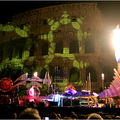SINCE 1637, when the irrationally exuberant Dutch tulip bulb market collapsed, it has been a cliché to say that the satiny, ephemeral blossom is the only thing that can drive the sensible Dutch to heights of fancy. “We went mad,” confirms Karin Hoogland, a manager at the Keukenhof, the giant spring garden near Lisse. “People really lost everything they had.”
But even a 10,000-florin bulb produced a flower — more than can be said for an interest-only mortgage. It’s this quality that has given the tulip staying power in Dutch culture. “We have these very dark, wet winters,” says Ms. Hoogland, “so when the tulips start blooming, it’s emotional.”
Spring visitors can’t miss the bright fields: flights approach Schiphol Airport over the sandy soil behind the Netherlands’ coastal dunes, perfect tulip country, roughly from Haarlem to The Hague.
In Haarlem, my wife, Nina, and I joined a giddy crowd at the Bloemencorso Bollenstreek (bloemencorso-bollenstreek.nl), the largest of many flower parades held across the country. Children danced under the influence of salty Dutch licorice as dozens of floral-psychedelic floats cruised by, each sculptured from countless blossoms. A vast Pippi Longstocking, a huge purple beer barrel and succulent-looking fruits as big as garden sheds scented the air for precise marching bands.
Mania is also in the air at the Keukenhof (open this year until May 20; admission 13 euros, or about $18 at $1.39 to the euro; an 18-euro ticket includes bus fare from the nearby Leiden train station; www.keukenhof.nl). Sharp, massed beds are set in emerald lawns beneath big, newly leafed beech trees. Tulips riot with billowing rhododendrons and azaleas, wisteria cascades, late daffodils and pavilions of orchids and cut roses. Peacocks wail in envy before the seven million bulbs.
The flower-to-visitor ratio is even better just outside the Keukenhof’s boundaries, where fields of tulips stretch to the flat horizon — the dabs of color visible from the air — the mother lode that produces bulbs for the whole world’s gardens.
We rented easy-riding Dutch bicycles for 8 euros and set off on the day’s suggested route, a glide through hyacinth-perfumed air over little bridges spanning still waterways plied by magnificent swans. The fields appear from a distance as pure form, but up close, individual blooms bob gently in the breeze, giving the landscape a hallucinatory shimmer.
The spell is broken only by the occasional whiff of agricultural chemicals. “The acres and acres of tulips in bloom are dazzling,” says Amy Stewart, author of the best-selling “Flower Confidential,” “but it’s also a factory: Holland is one of the few places people can get a glimpse of how the modern flower industry operates.”
The small Amsterdam Tulip Museum (Prinsengracht 112; 31-20-421-00-95; www.amsterdamtulipmuseum.com; admission 2 euros) details how tulips are grown, but the best way to see this industry in action is at the flower auctions. Visitors can watch the stunning scale of Dutch commerce at FloraHolland in Naaldwijk (www.floraholland.nl; tours are 2 euros and start at 8 a.m.) or Bloemenveiling Aalsmeer in Aalsmeer (www.vba.nl; admission 5 euros for tours starting at 7 a.m.), where nearly 20 million stems are sold each morning. Countless carts of flowers glide beneath huge, bewildering clock faces while a gallery of bidders determines the fates of growers worldwide.
But this efficiency spoils us. In Amsterdam, at the Rijksmuseum (www.rijksmuseum.nl; admission 10 euros), I stood rapt before Hans Bollongier’s 1639 “Still Life with Flowers,” a sheaf of broken tulips, anemones, roses, carnations and irises popping from murky shadows. At the time they were painted, these Golden Age bouquets — the icons to which every vase aspires — were impossible mixes from different seasons.
If today they are within reach, there is still more to art than mere variety. I find Amsterdam’s floating market to be irremediably touristy — for one thing, the stalls manage to float without any of the romance the concept implies: it looks like nothing more than a row of garden supply shops thick with souvenir hunters. Ten euros will buy a hundred mixed tulip bulbs, and 3.50 a bag of 10 select bulbs, but if you plan to take them home, make sure they really have been certified by the United States Department of Agriculture — a detail that has been misrepresented by unscrupulous or misinformed sellers.
But why bother? The same bulbs, from the same fields, are available at home. Instead, take advantage of the Netherlands’ perfect tulip-growing conditions and buy cut flowers. For the Dutch, flowers are an everyday necessity: you’ll see fresh bouquets everywhere, from homes to herring stands. You should follow their lead.
At the highly regarded florist Menno Kroon (Cornelis Schuytstraat 11; 31-20-679-19-50; www.mennokroon.nl), 50 euros will buy one of the freshest, best-considered bouquets in the world. Right now showy, long-stemmed organic tulips in the shop’s dark interior glow at least as wantonly as their nearly 400-year-old ancestors in the Rijksmuseum. Call ahead and have lush flowers greet you at your hotel.
For a more affordable bouquet, pick up several dozen tulips for a few euros at the outdoor Albert Cuypmarket, or visit ’t Lievertje (31-20-627-90-62), a stall at the corner of Kalverstraat and Hoek Spui. There, bouquets start at 15 euros and bags of U.S.D.A.-certified bulbs at 4.50. Accomplished, if surly (Don’t touch! No pictures!), florists whip together bounteous arrangements on sidewalk tables. Cigarettes dangle from the florists’ lips as they toil, and the street is slippery with discarded leaves, yet the work is impeccable, a hint of why many Dutch people find American bouquets lifeless.
And without life, there’s no point. Melancholy underlies the tulip’s beauty; perfection tempered by impermanence. If the Golden Age still lifes sought to prolong that moment, the impulse lives on: When we sat down at the Art Deco Café Americain near the Rijksmuseum, Nina had with her a single tulip — orange limned in yellow — that a florist had given her. By then the flower was flaccid, lying on the table like a visitor exhausted by a day spent sampling Amsterdam’s delights. A waitress rushed over, her brow furrowed in concern: “I’ll bring water right away,” she said, “for the tulip.”
This instinct is most realized at the Hortus Bulborum, in the otherwise unremarkable village of Limmen (open until May 16; 31-251-23-12-86; www.hortus-bulborum.nl; admission 3.50 euros). Because tulip bulbs are alive, each lineage must be grown every year or it will die out. At the Hortus Bulborum, more than 2,500 cultivars are grown in plots arranged alphabetically by variety. If it lacks the composition of the Keukenhof, the place draws serious flower fanciers for a glimpse of history literally alive.
Beds of ancestral wild tulips from the Silk Road bulb trade — weedy things with flowers like small crocuses — give way to dainty Duc van Tol Red and Yellow tulips, the oldest known surviving cultivar, grown each year since 1595. Nearby is La Reine, a compact white bloom shot with rose blush. One of the most-cultivated tulips ever, it nearly went extinct during the Depression. Black Beauty rises dour behind Double Earlies that look more like peonies than tulips, and a few steps away Hummingbird glistens Granny Smith green.
But to me the greatest treasure at the Hortus Bulborum is the showy Orange Favorite. First discovered right in Limmen in 1930, it is the most fragrant — yes, fragrant — variety of tulip known. When I found it, I knew tulip mania: I stooped in the sand, groveling to coax the heady, full scent from the just-unclenching buds, anxious not to lose it to the cool North Sea breeze.






